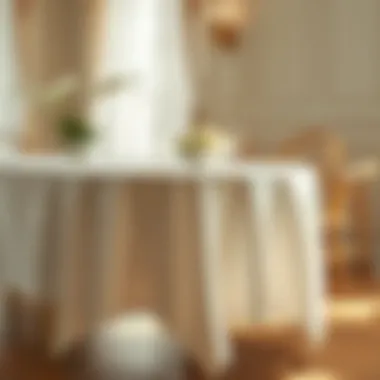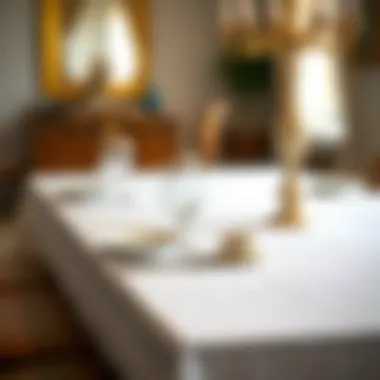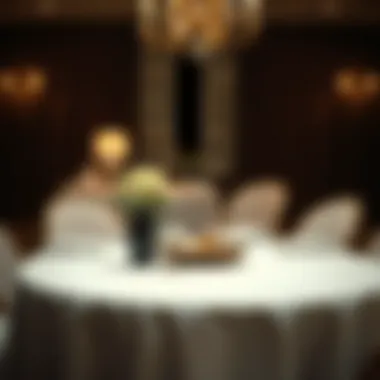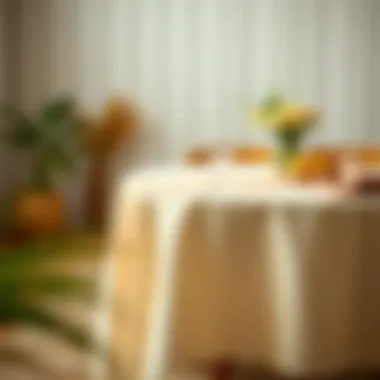The Importance of Plain Tablecloths in Modern Design


Intro
In the world of dining and home decor, the sheer power of simplicity can easily be overlooked. Amongst the din of elaborate table settings and flamboyant tableware, plain tablecloths make their quiet yet impactful presence known. Often perceived as the unsung hero of the dining table, they provide a canvas that enhances the dining experience while complementing the dishes they support. Their significance stretches beyond mere aesthetics; they hold historical roots and cultural relevance that many folks might not consider.
By exploring the material composition, functionality, and the cultural backdrop of tablecloths, we open a window to understand why such a basic element remains relevant in contemporary homes. How does a simple cover transform the ordinary dining experience into something memorable? Let’s dissect the true essence of plain tablecloths, providing insights that may inspire readers to rethink their dining spaces.
Fabric Knowledge
Understanding the materials that comprise plain tablecloths is vital. The fabric can influence the overall look, feel, and functionality.
Types of Fabrics
There’s a diverse range of fabrics that can be used for tablecloths, each offering unique characteristics:
- Cotton: This popular choice is durable, breathable, and easy to clean. It's versatile in designs and easy to maintain, making it a staple for everyday use.
- Linen: Known for its luxurious texture and aesthetic appeal, linen conveys elegance while providing durability against wear. However, it requires careful handling to maintain its crisp appearance.
- Polyester: This synthetic fabric offers stain resistance and is often machine washable, making it a practical option for families and hosts.
- Vinyl: Perfect for outdoor settings and casual dining, vinyl tablecloths are waterproof and easy to wipe clean, though they lack the sophisticated touch of natural fabrics.
How to Care for Different Fabrics
Proper care extends the life of a tablecloth. Here’s how to look after different types:
- Cotton: Wash with similar colors in cold water. Avoid high heat during drying to prevent shrinkage.
- Linen: Hand wash or a gentle cycle in cold water is best. Iron while damp to maintain that smooth finish.
- Polyester: Machine washable; low heat is recommended for drying. Stains can often be removed with little effort, thanks to its resilient properties.
- Vinyl: Wipe with a damp cloth and mild soap. Avoid abrasive materials that may scratch the surface.
Style Tips
When dressing your table, how one pairs tablecloths with other elements can make all the difference. From decor to mood, let’s explore how you can style with plain tablecloths effectively.
Outfit Pairing Strategies
Plain tablecloths can be dressed up or down, making them incredibly versatile. Here’s how to maximize their potential:
- Layering: Using a patterned runner or placemats on top can create visual interest.
- Centerpieces: A beautiful floral arrangement or a statement bowl can elevate the table setting without overwhelming it.
- Dishes Compatibility: Opt for dishware that contrasts or complements the cloth—earthy tones often pair well with lighter fabrics while vivid colors may stand out against neutral tones.
Seasonal Fashion Trends
As seasons change, so do style trends. Consider the following:
- Spring/Summer: Light and airy fabrics like cotton in pastel colors evoke a fresh feel, suitable for sunny days. Crisp white tablecloths can be paired with wildflower centerpieces for a charming look.
- Autumn/Winter: Rich, heavier fabrics, especially in jewel tones, can create a cozy atmosphere during festive gatherings. Layering tablecloths can add depth and warmth to the tablescape.
"The dining table often serves as the stage for memories, stories, and laughter—plain tablecloths frame these moments as quietly yet beautifully as possible."
In closing, a plain tablecloth is more than a ubiquitous furnishing item; it embodies a blend of practicality and style that enhances any dining experience. By understanding the materials, caring for different fabrics, and aligning the tablecloth with current trends and pairing strategies, anyone can transform their dining area into a welcoming haven. As we continue this exploration, the goal is to not only appreciate the tablecloth but also elevate our dining spaces with simple strokes of style.
Understanding the Concept of a Plain Tablecloth
When it comes to dining décor, the plain tablecloth often falls into the realm of the overlooked. Yet, its significance is far-reaching, providing both functional and aesthetic benefits. A plain tablecloth sets the stage, transforming a simple table setting into a canvas for culinary presentations and social gatherings. This section aims to peel back the layers and take a closer look at what defines a plain tablecloth, its materials, and its undeniable value in our homes.
Defining Plain Tablecloths
A plain tablecloth is just that—unembellished fabric draped over a table, devoid of patterns or intricate designs. It may seem mundane, but its simplicity offers an elegant touch to any setting. This kind of table covering serves multiple purposes, from protecting the table surface to enhancing the overall ambiance of a meal. In a world often saturated with complexity and flair, the plain tablecloth champions simplicity, allowing it to shine in its unpretentiousness.
Common Materials Used
The choice of material can greatly influence the performance and aesthetic of a tablecloth. Here are some common materials, each adding its unique character to the plain tablecloth collection.
Cotton
Cotton is widely favored for its softness and breathability. This natural fiber feels good against the skin, making it an inviting choice for both casual family dinners and more formal occasions. It’s easy to wash, typically coming out of the laundry fresh and wrinkle-free, which is a plus for busy households. While cotton tablecloths hold their color fairly well, they can be prone to staining. That said, their ease of cleaning often outweighs this minor setback.
Linen
Linen brings a touch of sophistication to the table. Known for its smooth finish and natural luster, linen tablecloths can elevate the dining experience. The fabric is strong and durable, ensuring that a well-cared-for linen tablecloth can last for years. Its unique characteristics include an ability to wrinkle, but many regard this as part of its charm. This material is a staple for more formal settings and events, where the richness of texture can make all the difference.
Polyester
On the more practical side, polyester is a go-to for many households. It’s exceptional in terms of stain resistance and durability, often outlasting cotton and linen in everyday usage. Polyester tablecloths tend to be more affordable as well, which is a significant advantage for those on a budget. However, they may not offer the same level of breathability as natural fibers, which could affect the overall dining experience in warmer climates.
Blends
Blended fabrics combine the strengths of both natural and synthetic fibers, providing a balanced option for consumers. A cotton-polyester blend, for instance, offers the soft touch of cotton along with the durability and wrinkle resistance of polyester. This flexibility allows for a diverse range of looks and feels, which can cater to a variety of preferences and occasions. While blends may slightly compromise the unique qualities of each individual material, they often strike a practical balance, making them a popular choice for everyday use.
In summary, the essence of a plain tablecloth embodies more than just fabric; it encapsulates a rich blend of purpose, material choice, and style. Understanding these elements enhances our appreciation for something that may initially seem so simple. By taking a closer look at the materials and defining characteristics of plain tablecloths, we can better appreciate their role in enhancing our dining experiences.
Historical Perspectives on Tablecloths
Understanding the historical perspectives on tablecloths unveils a rich tapestry that connects us to our dining traditions. A plain tablecloth, seemingly simple at first glance, has evolved over centuries, frequently reflecting the cultures and values of different eras. This exploration of history underscores how tablecloths have transcended their functional purposes to embody socio-cultural significance and artistry.


The Evolution of Table Drapery
The journey of table drapery is as old as time itself, rooted in practical needs but branching out into an art form. Initially, cloth served to protect surfaces during meals – a humble yet vital purpose. As civilizations advanced, tablecloths began to be adorned and stylized, evolving along with societal norms. Early on, the cloths were often remnants of whatever fabric was available; materials ranging from rough wool to delicate linen. By the Middle Ages, tablecloths became more standardized, signaling a newfound appreciation for domestic aesthetics. The introduction of printing techniques further allowed for creativity, with patterns and colors reflecting wealth and status.
Cultural Significance Across Eras
Renaissance Dining
During the Renaissance, dining moved beyond mere sustenance; it turned into a visual showcase of wealth and sophistication. The Renaissance dining table was adorned not only with food but also with intricate tablecloths that expressed the wealth and culture of a household. These cloths were often embroidered with ornate designs or rich colors, setting a lavish atmosphere. The key characteristic of Renaissance Dining was its focus on aesthetics. It showcased how a plain tablecloth, even when simple, could elevate a meal into an experience, making it a favored choice among the affluent.
However, the downside was that such rich adornments came at a price, often out of reach for common folk. Yet, even the lower classes adopted simpler, but equally aesthetic, plain tablecloths to reflect a sense of decorum in their meals.
Victorian Etiquette
Transitioning into the Victorian era, table etiquette saw an explosion of rules that dictated how dining should occur. The tablecloth took center stage as it became a symbol of grace and poise. A well-set table with a meticulously clean and pressed tablecloth was a must to maintain the aura of respectability. The Victorian era's obsession with decorum meant that guests often assessed hosts based on the quality and cleanliness of their tablecloths.
The core characteristic here was that Victorian Etiquette imposed rigid standards. While it promoted a higher standard of cleanliness and respectability in dining, it placed many unnecessary pressures on hosts to maintain appearances with lavish or extravagant setups.
Modern Minimalism
Modern Minimalism marks a departure from the ostentatious displays of previous eras. This artistic movement embraces simplicity and functionality, including in home decor. The key feature of Modern Minimalism is its advocacy for uncluttered living spaces, where even table settings opt for refreshing simplicity. Plain tablecloths in neutral tones became a staple in many households, serving as versatile backdrops that can enhance the overall dining experience without overwhelming it.
Nevertheless, there is a fine line to balance in minimalism; while simplicity can be elegant, it might also risk seeming sterile or devoid of character if not paired thoughtfully with other elements. Yet, many find that the allure of a well-chosen plain tablecloth, paired with clever minimalistic décor, yields both charm and warmth to the dining ambiance.
"A tablecloth may seem like a trivial detail, but in reality, it holds the power to transform a meal into an event."
In summary, the historical perspectives on tablecloths highlight their evolution from basic protective coverings to symbols of cultural identity and aesthetics across various eras. Understanding this evolution allows us to appreciate the role of plain tablecloths not just as mere fabric but as active participants in the rich tapestry of dining tradition.
Functional Aspects of Plain Tablecloths
Plain tablecloths serve several vital functions that not only protect surfaces but also enhance the overall dining experience. Understanding these functions can help one appreciate their essential role in both casual meals and formal gatherings.
Protection of Surfaces
A primary role of tablecloths is the protection of surfaces. Whether the table is made from solid oak or glass, plain tablecloths act as a buffer against spills, scratches, and heat damage. A simple cotton or linen tablecloth can absorb coffee stains before they reach the wood, sparing the table from damage that can accumulate over time. Additionally, they provide a barrier that protects against accidental scratches from cutlery or serving dishes.
- Heat Resistance: Depending on the fabric material, plain tablecloths can help prevent heat from hot dishes from transferring directly onto the table surface.
- Ease of Cleaning: Many materials allow for quick cleaning by simply tossing them in a washing machine, hence maintaining an immaculate tabletop.
These protective qualities make them a must-have in any dining space, where frequent meals can lead to wear and tear on surfaces.
Enhancing Dining Experience
Beyond their protective qualities, plain tablecloths enhance the dining experience in multiple ways. They set the stage for meals, influencing ambiance and comfort in significant manner.
Mood Setting
The choice of a plain tablecloth can dramatically impact the mood of a dining setting. For instance, a crisp white tablecloth conveys a sense of elegance and formality, while softer pastels may evoke warmth and comfort.
- Key Characteristic: The neutrality of a plain tablecloth complements various dish presentations and decorations, allowing the food to be the star of the show.
- Benefits: A well-chosen tablecloth can ease tension and promote a relaxed atmosphere. Offering a simple visual background can enhance the experience of sharing a meal, encouraging conversations to flow freely.
In settings such as family gatherings, a light-colored tablecloth may foster a more welcoming space, aligning with the communal aspect of dining.
Aesthetic Appeal
The aesthetic appeal of plain tablecloths stems from their simplicity and versatility. A neutral covering provides a canvas for everything else on the table, from beautifully arranged dishes to vibrant flower centerpieces.
- Key Characteristic: Its lack of pattern allows for easier pairing with various tableware, making it a flexible choice across different dining occasions.
- Uniqueness: A minimalist approach means anyone can express personal style without creating visual chaos.
This visual harmony can transform an ordinary meal into something special. However, choosing a tablecloth with visible wear can detract from the occasion, highlighting the need for maintaining the cloth in good condition.
"Simplicity is the ultimate sophistication." – Leonardo da Vinci
Incorporating plain tablecloths in dining settings is not just about functionality; it’s about cultivating an environment that is both pleasing to the eye and conducive to enjoyment. Thus, they stand as a key element in balancing function with aesthetic appeal, maintaining their significance across different dining contexts.
Versatility of Plain Tablecloths
Plain tablecloths hold a unique position in the realm of dining and decor, effortlessly bridging the gap between various styles and occasions. Their versatility is not just a matter of aesthetics, but significantly contributes to function and ambiance in both formal and casual settings.
By serving as a blank canvas, plain tablecloths allow room for creativity. They provide the opportunity to enhance the visual appeal of the table without overshadowing the elements already in place, whether it be exquisite dinnerware or carefully selected centerpieces. From intimate family dinners to extravagant gatherings, plain tablecloths adapt seamlessly, illustrating their essential role in any host's toolkit.
From Formal to Casual Settings
Plain tablecloths can transition from a regal dinner party with fine china to a relaxed barbecue with friends. In formal settings, the elegance of a white or cream tablecloth adds an air of sophistication, allowing for lovely contrasts against jewel-toned linens or vivid floral arrangements. The smooth, uninterrupted surface can make meals feel more refined, creating a heightened experience for guests.
In contrast, in casual environments, a simple cotton or linen tablecloth can instill a welcoming vibe. The choice of colors—perhaps a soft pastel or gingham pattern—creates a relaxed atmosphere, making gatherings feel more approachable yet still tastefully decorated. In essence, because of their adaptability, plain tablecloths do not just complement gatherings—they enhance them, forging a unique connection between the table setting and the guests.


Adaptation in Various Aesthetic Styles
The adaptability of plain tablecloths shines through when examining their integration into different aesthetic styles.
Traditional
Traditional tablecloths often embody classic designs and color schemes, echoing the historical significance of dining culture. The use of intricate embroidery or lace as a texture complements rich, dark wood furniture, creating a cozy and inviting atmosphere. The hallmark of this style typically includes subtle patterns or classic colors like deep reds, browns, or beige shades.
However, while these classic designs add elegance, they may require more maintenance and specific care to preserve their aesthetic appeal. This can be cumbersome for those who prefer low-maintenance solutions.
Contemporary
Contemporary tablecloths embrace simplicity and clean lines, focusing on understated elegance. With neutral tones or solid colors, they provide a backdrop that highlights modern decor elements—allowing the dining experience to take center stage without unnecessary distractions. This style is especially enjoyable for those who appreciate minimalist design principles.
The unique feature of contemporary tablecloths lies in their materials, often blending synthetic fibers that afford easy care and durability, suitable for everyday use. Yet, this practicality can sometimes lack the warmth or character that natural fabrics provide.
Eclectic
Eclectic styles celebrate diversity and individuality. Here, plain tablecloths can take on many forms—ombre effects, unexpected pops of colors, or mixed-textures—that embody a style driven by creativity and personal expression. This option proves beneficial for those who want to make dynamic statements in their dining spaces.
Unlike traditional or contemporary styles, eclectic designs allow for versatility not bound by conventional rules. However, the challenge comes in the need for a keen aesthetic sensibility; an unbalanced mix can lead to an overwhelming look.
In fact, integrating plain tablecloths into eclectic decor can strike a perfect balance, anchoring the visual elements while still allowing for artistic expression.
In summary, the versatility of plain tablecloths extends well beyond mere functionality—they are the silent facilitators of style. Whether in traditional, contemporary, or eclectic arrangements, their role remains impactful, offering diverse options tailored to individual preferences and occasions.
Curating the Right Tablecloth for Every Occasion
Selecting the right tablecloth is akin to laying the groundwork for a splendid dining experience. A plain tablecloth doesn’t merely provide a covering; it enhances the atmosphere, adds sophistication, and tells a story about the gathering at hand. Each occasion demands a specific style, color, and texture to best fit the intended mood, theme, and purpose. Whether it's a sunny brunch or a formal dinner, understanding how to curate your tablecloth to match the occasion is a skill that adds value both to everyday meals and special events.
Tablescapes and Themes
Seasonal Themes
Seasonal themes in tablecloth selection are a delightful way to echo the essence of a particular time of year. Whether it be vibrant shades for spring or darker hues during autumn, choosing a plain tablecloth that aligns with the seasons creates a harmonious connection with the outdoors. Its greatest charm lies in its ability to adapt; it’s like a chameleon, effortlessly blending into any seasonal vibe. The subtlety of seasonal colors and textures can make your table feel warm and inviting, all while keeping the focus on the food or social interaction at hand.
However, the downside might come from the limitation of relying solely on these themes. Seasonal choices can feel dated when not refreshed yearly, making some unique hues less appealing after a while.
Family Gatherings
Family gatherings call for a warmth that only a well-chosen tablecloth can provide. Here, it’s not only about protecting the table but creating a setting for connection and conversation. A simple, soft fabric in earthy tones or pastel shades can make all the difference, as it complements home-cooked meals and nostalgic stories shared over dinner. These gatherings are often filled with laughter and cherished moments, and a thoughtfully chosen tablecloth enhances the ambiance.
Yet, flexibility is key when it comes to family gatherings. While light fabrics might collect stains more easily, it also provides an opportunity to celebrate imperfections, as spills often become stories of their own.
Formal Events
For formal events, the art of choosing the right tablecloth becomes paramount. A clean, crisp white or deep navy blue plain tablecloth lends an air of elegance that speaks volumes about attention to detail and the importance of the occasion. It sets an understated tone that allows other elements of decor to shine, reinforcing the overall sophistication of the gathering.
Nevertheless, one must be cautious. The wrong type of fabric can lead to creasing or wear which might detract from a polished appearance. While smooth textures often scream luxury, they require a bit more maintenance. This delicate balance showcases the need for careful selection and preparedness for any gathering.
Choosing Colors and Textures
Neutral Palettes
Neutral palettes are a classic choice for any table setting. These color schemes, ranging from soft whites to earthy browns and grays, create a calming backdrop that doesn't overpower the dining experience. By promoting simplicity, they allow the beauty of the food and the joy of gathering to take center stage. Neutral tablecloths can transition seamlessly from one occasion to the next, making them a valuable investment for any home.
While they provide versatility, the challenge might be on achieving harmony with other colors present in the decor. Too many patterns can muddle the overall look; therefore, one must find the sweet spot between neutrality and adding pops of personality with decor elements.
Textured Fabrics
Textured fabrics bring about depth and interest to a seemingly plain tablecloth. From linen’s natural feel to the warmth of cotton, these materials can enhance the dining experience, inviting guests to touch and feel the fabric as they settle in. A textured tablecloth captivates attention and draws people in, making it a popular choice, especially for more intimate gatherings.
However, asymmetrical textures could pose a small issue. They can sometimes clash with the smooth lines of tableware. Yet, when well-balanced, textured fabrics can elevate an entire table setting, creating a rich tapestry that communicates warmth and love.
Layering Techniques
Layering techniques add a creative twist to the presentation of a plain tablecloth. Utilizing a base tablecloth with an accompanying runner or overlay can create dimensions and highlight certain styles. This technique is ideal for showcasing individual pieces or adding a dash of color or texture without overwhelming the overall look. Layering gives one the freedom to mix and match, thereby infusing a personalized aspect into any setting.
Nonetheless, excessive layering might turn chaotic, drawing attention away from the food rather than enhancing it. Careful consideration needs to be taken to ensure each layer complements rather than competes. This method, when done right, can transform any plain tablecloth into a significant focal point with style.
In essence, the art of curating the right tablecloth for various occasions lies in a blend of understanding the underlying theme, suitable materials, and the overall mood you want to create. The choices you make not only impact the aesthetic but also the warmth and comfort of every dining experience.
By weaving these key aspects together, one can ensure that every table setting tells a story, inviting guests to indulge not just in the meal, but in the overall ambiance crafted with care.
Maintenance and Care of Plain Tablecloths


Maintaining a plain tablecloth goes beyond merely washing it every now and again; it embodies a commitment to sustaining the beauty and functionality that such a simple piece of fabric can provide. The significance of proper care cannot be overstated, especially considering the various roles these tablecloths play in our dining experiences. A well-kept tablecloth not only protects surfaces but also enhances the overall aesthetic of the dining area.
Good maintenance practices ensure longevity, allowing these fabrics to remain part of cherished family traditions for years. In addition, understanding the nuances of cleaning, drying, and stain treatment positions one to navigate the occasional mishap, be it a spill of red wine or an uninvited splash of tomato sauce.
Washing and Drying Instructions
When washing plain tablecloths, it’s essential to pay attention to the type of material being washed. Here are a few key points to consider:
- Cotton tablecloths can usually be thrown into the washing machine on a warm cycle, but it’s wise to check the care label. Line drying is also preferred to minimize shrinking.
- Linen tablecloths may require a gentler cycle and should be ironed while slightly damp to maintain their natural fibers.
- For polyester blends, these are often more straightforward; toss them in and use a tumble dryer on low.
Sustainability and Ethical Considerations
In today’s world, the conversation around sustainability extends beyond just recycling and composting; it encompasses the very fabrics that adorn our tables. The importance of incorporating sustainability and ethical considerations into the choices we make when selecting plain tablecloths lies in the impact they have on our environment and society. As consumers become increasingly aware of their purchasing power, the demand for eco-friendly products, including table linens, is on the rise. This section will explore how choosing sustainable materials and practices can reduce our carbon footprint while enhancing the beauty of our dining experiences.
Choosing Eco-Friendly Materials
When it comes to selecting a tablecloth, the material is perhaps the single most significant factor that contributes to its sustainability. Here’s a closer look at some eco-friendly materials that can be found on the market:
- Organic Cotton: Grown without synthetic pesticides or fertilizers, organic cotton is a sustainable choice. Using this material not only supports healthier farming practices but also helps preserve soil and local ecosystems.
- Tencel (Lyocell): Made from sustainably sourced wood pulp, Tencel is biodegradable and has a lower environmental impact during production compared to conventional fabrics. Its soft texture and high water absorption make it an excellent option for tablecloths.
- Hemp: A hardy plant that requires minimal water, pesticides, and fertilizers to grow, hemp fabric is not only durable but also sustainable. Hemp tablecloths can bring a rustic charm to any dining setting.
- Recycled Polyester: Sometimes referred to as rPET, this material is made from recycled plastic bottles. Opting for recycled polyester tablecloths keeps plastic out of landfills and reduces the need for virgin materials.
Choosing tablecloths made from these materials can elevate your dining decor while adhering to ethical standards. The immediate benefit is clear: a reduced impact on surroundings, which translates to a better quality of life both globally and locally.
The Role of Sustainable Practices in Textile Production
The sustainability of tablecloths isn’t solely in the materials used; it extends to the entire production process. The textile industry has been known for its heavy environmental toll, from water consumption to carbon emissions. However, various sustainable practices are now being implemented to mitigate these effects:
- Water Conservation: Efficient water management systems can significantly reduce water usage in textile production. Technologies like waterless dyeing methods contribute to this effort tremendously.
- Energy Efficiency: By utilizing renewable energy sources, such as solar or wind, manufacturers can decrease their reliance on fossil fuels, thus lessening their carbon footprint. This is crucial to maintaining an ethical production line.
- Fair Labor Practices: Ethical production also means treating workers fairly. Factories that prioritize fair wages, safe working conditions, and reasonable working hours reinforce the notion of sustainability.
- Local Production: Sourcing and producing materials locally not only cuts down on emissions tied to transportation but also supports local economies.
In summary, sustainable practices are vital to ensure that the production of plain tablecloths respects both people and the planet. A commitment to sustainable choices can lead to a future where our dining experiences contribute to a healthier ecosystem rather than detract from it.
"Buying a tablecloth shouldn’t just be about aesthetics; it should reflect values that matter to us all."
Embracing sustainability in our home décor, especially through something as simple as a tablecloth, can set a precedent for future consumer habits. It emphasizes that even an everyday item can play a role in creating a more responsible world.
Emerging Trends and Innovations
In an era where the aesthetic is paramount, one might overlook the humble plain tablecloth's potential to innovate. Yet, innovation doesn't only belong in the realm of flashy designs or vibrant patterns. Instead, emerging trends show a distinct shift toward practicality, sustainability, and personalization in table decor. These aspects are not just whims of fashion; they have profound implications for the way we experience dining.
Smart Fabrics in Tableware
The intersection of technology and textiles has brought about smart fabrics for tableware, which are not only functional but can enhance the dining experience significantly. Think about tablecloths that can repel stains or even change color according to the mood of the meal or the occasion. This is not a far-off dream—it's rapidly becoming a reality.
- Stain Resistance: Fabrics embedded with nano-coatings can resist dirt and spills, allowing for easy cleaning. This means your dinner parties can transition smoothly without the anxious worry of red wine stains or sauce splatters ruining the fabric.
- Temperature Control: Some innovative fabrics are designed to maintain a comfortable surface temperature, allowing diners to enjoy their meals without the annoyance of steaming hot or icy surfaces.
- Adjustable Aesthetics: Imagine a tablecloth that can change its hue—perhaps a pristine white for formal occasions and a warm beige for more casual gatherings. These fabrics promise not only to save money in the long run but also to provide endless creative possibilities in dining settings.
As smart textiles find their place in everyday life, they will redefine what a simple tablecloth can achieve.
Customization and Personalization Options
In a world increasingly obsessed with individuality, customization stands as a driving trend in tablecloth designs. The plain tablecloth, often overlooked, is becoming a canvas for personal expression. The ability to modify aspects of design allows users to imprint their identity into their dining experiences.
- Initials and Monograms: A simple yet impactful way to make a tablecloth unique is through monogramming. A personal touch adds warmth and a sense of belonging to the dining table, making even routine meals feel special.
- Choice of Fabrics: Today, individuals can choose their preferred material based on their lifestyle needs. For instance, busy families may opt for durable polyester blends that are easy to clean, while those seeking elegance might go for pure linen, adding texture and class to their table setting.
- Personalized Patterns and Colors: Many retailers are now allowing customers to upload their designs or select colors, ensuring that their tablecloth matches the overall decor theme of their home or occasion.
Customization and personalization not only enhance the aesthetic value; they create experiences—turning each gathering into an event that resonates with the unique tastes of the host.
"In the realm of dining decor, the plain tablecloth is shifting from a necessity to a statement piece—flexible, capable, and bursting with personality."
As the trends emerge and expand, the plain tablecloth stands ready to adapt, bearing witness to our surroundings while ensuring functionality and personalization are at the forefront of dining experiences.
Ending: The Enduring Charm of Plain Tablecloths
In a world that's fast-paced and often cluttered, the plain tablecloth stands out as a testament to timeless elegance and simplicity. It is not merely a piece of fabric thrown over a table; it is an embodiment of charm that enhances any dining experience. The charm of a plain tablecloth resonates from its ability to create a unified look while allowing the beauty of food and gathering to shine through.
A plain tablecloth, whether in subdued colors or natural textures, serves many purposes. First, it brings a certain cohesiveness to a dining arrangement. In moments where a table is filled with various dishes, drinks, and decorative pieces, the plain fabric helps in centering the focus, much like an orchestra conductor bringing harmony to the ensemble.
Moreover, this simplicity offers versatility. It adapts to various themes, occasions, and dining styles. From an intimate family dinner to a large festive gathering, the plain tablecloth effortlessly transitions, proving to be a reliable choice. Its role is especially significant in juxtaposition to vibrant or ornate dining setups, as it can ground an otherwise busy scene.
A plain tablecloth is more than just a covering; it's a canvas for memorable gatherings and an understated symbol of hospitality.
Maintenance of these tablecloths is also a breeze compared to their more complex counterparts. Easy to clean and resistant to wear when well cared for, they encourage frequent use without the constant worry of wear and tear that more extravagant textiles might invite. Also, in an age where sustainability is increasingly prioritized, opting for a plain tablecloth made of eco-friendly materials elevates its charm even further, aligning it with a conscientious lifestyle.
Simplicity Meets Style
Embracing simplicity does not mean compromising on style. In fact, plain tablecloths can often make a stronger style statement than their busier counterparts. The subtle texture of a linen cloth or the softness of cotton can add depth to a table setup without overshadowing it with distractions.
Consider how a white cotton tablecloth transforms an everyday dinner into something special simply through its unpretentious presence. It welcomes guests with warmth, reinforcing the notion that simplicity is not synonymous with blandness but rather offers a refined aesthetic.
Depending on the occasion, layering a plain tablecloth with simple runners or adding a few calming centerpieces can elevate the overall look without overpowering the essentials. Neutral palettes allow for creativity and personalization—mixing with plates, glasses, and utensils in varied colors becomes a delightful exercise in aesthetics, granting the host freedom to express their style uniquely.
The Future of Dining Decor
The evolving landscape of dining decor is seeing a return to authenticity and sustainability. Plain tablecloths, as part of this movement, are becoming more than just utilitarian objects. They are now viewed through a contemporary lens where thoughtful design meets sustainable practices. The trend seems to aim for a balance between simplicity and elegance, where every piece on the table holds significance.
As people become more mindful of their choices, the future will likely see an increase in customized options for plain tablecloths. Whether through modern printing techniques that showcase personal artistic touches or choosing biodegradable materials, the possibilities are expanding. The essence remains—keeping things simple while making meaningful connections, one tablecloth at a time.















